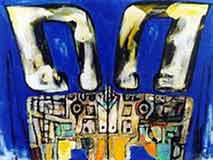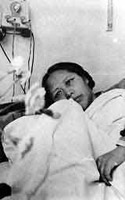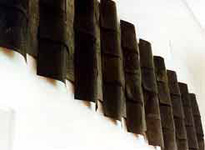Three Generations of Chinese Modernism
Art Beatus Vancouver, April 22 to May 30, 1998


Vancouver, B.C. – In collaboration with the city-wide project titled Jiang Nan- Modern & Contemporary Chinese Art from the South of the Yangzi River, Art Beatus Gallery and the Annie Wong Art Foundation are pleased to present Three Generations of Chinese Modernism from April 22 to May 30, in order to coincide with the International Symposium on Modern & contemporary art from the Jiangnan region to be held at the Emily Carr College of Art & design on April 24 & 25.
 Three Generations of Chinese Modernism looks closely at the
lives of 3 women artists across 3 generations in China that covers 60
years of turbulent history. Artists Qiu Ti, Pang Tao & Lin Yan,
with same family lineage, faced much hardship in different times in
order to pursue their art practices. Their artworks are testaments to a
past largely ignored by Modern Chinese art history.
Three Generations of Chinese Modernism looks closely at the
lives of 3 women artists across 3 generations in China that covers 60
years of turbulent history. Artists Qiu Ti, Pang Tao & Lin Yan,
with same family lineage, faced much hardship in different times in
order to pursue their art practices. Their artworks are testaments to a
past largely ignored by Modern Chinese art history.
Qiu Ti was one of the two female painters in the short lived Storm Society at Shanghai in 1930’s. Her bold still life paintings on view at Art Beatus challenged conventional art practice at the time. Qiu Ti together with the Storm Society were the pioneering force that introduced the first wave of western modernism to China and had altered the course of modern Chinese art history. Qiu Ti died weeks after the persecution of her husband by the anti rightist movement in 1958.
The paintings of Qiu Ti appear peaceful and meditative, but their calm exterior is deceptive. Behind these lyrical paintings lies a lifelong struggle against stiffling orthodoxes.
These paintings celebrate private life and personal observation. They are full of details - a black lacquer box casually open beside a bed of roses, for instance, or pottery ornamented with Chinese patterns - which reveal the artist's desire to give the still life genre a Chinese face.
Pang Tao, as the daughter of the hated Qiu Ti, was exposed to modern art throughout her childhood. Due to Pang Tao’s background in 1957, at the age of 23 Pang was sent for reeducation in countryside and produced official paintings. In 1980’s, Pang Tao had the rare opportunity to spend 1 year in Paris to absorb new western influences. Pang Tao, bearing the avant-garde vision of her mother, was the first professor to shift from realistic to semi abstract at the prominent Central Academy of Fine Arts, Beijing. The inspiration for the bronze series on view is recent works of intriguing semi abstract representation of historical bronze vessels.
Drawing on approaches to abstraction drawn from Cubism, Abstract Expressionism, and Constructivism, Pang Tao creates formal compositions inspired by the most ancient of Chinese art forms. Balancing old and new, tradition and innovation, and abstraction and representation, she carries on her mother's search for a Modernism that expresses a Chinese spirit.
Lin Yan, the daughter of Pang Tao, granddaughter of Qiu Ti, also studied art at the Central Academy. She was more fortunate than her mother and grandmother and could pursue her art study at the Ecole Des Beaux-Art in Paris in 1985. Her current works are thoughtful resolutions of the deprived history of her grandmother. The use of blackness in her installation titled Grandma’s Garden leaves one with a sense of grief and distance.
 From
a Western perspective, her work appears to be a female response to the
mute aggression of certain varieties of Western minimalism. Instead of
corten steel and iron, she creates constructions from wood and canvas
painted a deep, mesmerizing black. The surfaces of her works contain
marks, imprints and shades of black which appear to change in different
lights and from different angles. As a result, they have a delicacy
that owes more to the restrained spirituality of Ad Reinhardt than to
the brute materiality of Richard Sierra.
From
a Western perspective, her work appears to be a female response to the
mute aggression of certain varieties of Western minimalism. Instead of
corten steel and iron, she creates constructions from wood and canvas
painted a deep, mesmerizing black. The surfaces of her works contain
marks, imprints and shades of black which appear to change in different
lights and from different angles. As a result, they have a delicacy
that owes more to the restrained spirituality of Ad Reinhardt than to
the brute materiality of Richard Sierra.
An Asian perspective adds another layer of meaning. Lin Yan notes this body of work was inspired by a 1994 visit to her native Beijing.. After a nine year absence, she found the city alomst unrecognizable. High rises and modern office buildings were replacing the traditional houses of her childhood. She began creating black paintings as a kind of elegy to the city she remembered.
Art Beatus, with galleries in Vancouver, Canada and Hong Kong, focuses on international contemporary Chinese art. The Vancouver gallery is on the upper plaza at 888 Nelson Street.
For
further information, please contact:
Canada: tel: (1) 604.688.2633, fax: (1) 604.688.2685